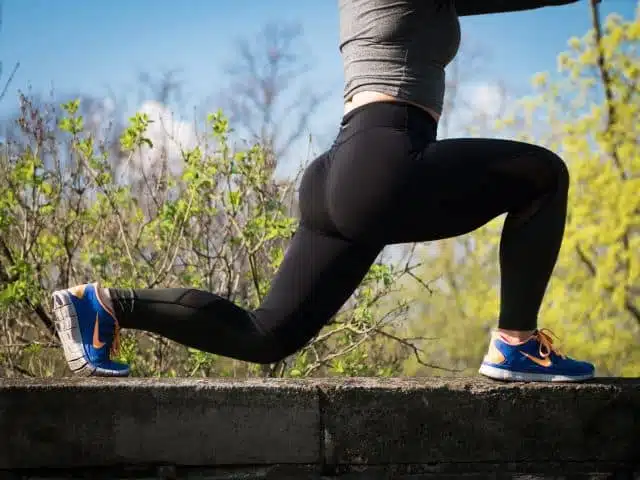Reverse Slide Lunge Exercise: Benefits, Muscles & How to Do
If you’re aiming to build strong, stable, and athletic legs, the reverse slide lunge is one of the most effective exercises to include in your routine.
While back squats and deadlifts are essential for leg development, single-leg exercises like reverse slide lunges are crucial because many daily activities and sports require single-leg strength.
As a 6’10” professional basketball player, I find reverse slide lunges particularly beneficial for keeping my legs and knees in top condition.
What is the Reverse Slide Lunge Exercise?
Reverse slide lunges are a powerful lower-body exercise designed to enhance strength, stability, and agility.
This movement involves sliding one foot backward into a lunge position using a sliding surface such as a slideboard, glide disc, or even a towel on a smooth floor.
By engaging key muscle groups like the quadriceps, hamstrings, and glutes, reverse slide lunges promote balanced movement and provide an effective way to improve lower-body strength and coordination.
How to Do a Reverse Slide Lunge
In this movement, athletes slide their foot backward into a lunge position by using a sliding surface, such as a slideboard, glide disc, or a towel on a smooth floor.
Here is an example of me doing some bodyweight reverse slide lunges in my apartment with only glide discs on a carpeted floor:
Reverse Slide Lunge Muscles Worked
Reverse slide lunges primarily target the following muscles:
- Quadriceps: The front thigh muscles are heavily engaged as they work to extend the knee during the lunge movement.
- Hamstrings: These muscles at the back of the thigh help stabilize the movement and control the descent into the lunge position.
- Glutes: The gluteus maximus is particularly activated during hip extension, helping to drive the body back up to the starting position.
- Adductors: The inner thigh muscles assist in stabilizing the legs during the sliding motion.
- Calves: The calves provide support and balance during the lunge.
- Core: The core muscles, including the abdominals and obliques, are engaged to maintain stability and balance throughout the movement.
- Hip Flexors: These muscles stretch during the backward sliding motion, helping to improve flexibility and mobility.
Reverse slide lunges provide a comprehensive lower-body workout while also enhancing core stability and balance.
How Often Should You Do Reverse Slide Lunges?
The frequency of reverse slide lunges depends on your fitness level and goals.
Beginners should start with 2-3 sessions per week, while more experienced individuals can incorporate them more frequently.
Listen to your body and adjust the frequency based on muscle soreness, fatigue, and overall recovery.
Incorporating rest days is essential to avoid overtraining and promote muscle growth.
Reverse Slide Lunge Benefits
Reverse Slide Lunges are a dynamic lower-body exercise that effectively engages multiple muscle groups, making them beneficial for both athletes and fitness enthusiasts.
This versatile movement primarily targets the quadriceps, hamstrings, and glutes, promoting strength and endurance in these key areas.
The backward stepping motion activates the quadriceps as they work to extend the knee, while the hamstrings dynamically stabilize the movement and control the descent into the lunge position.
Simultaneously, the glutes play a crucial role in hip extension, contributing to overall lower-body strength.
Additionally, reverse slide lunges require core activation for stability and balance.
This comprehensive muscle engagement makes reverse slide lunges a valuable addition to training routines, offering a holistic approach to lower-body strength development for individuals pursuing athletic performance or general fitness goals.
Reverse slide lunges work all the major muscles in your lower body, and also provide for some core work as well.
Here are a few of the most significant benefits of the reverse slide lunge exercise:
Enhanced Glute Activation
Reverse slide lunges are excellent for activating the glutes, which can be underdeveloped with bilateral exercises.
Strong glutes are essential for a healthy back and athletic performance.
Improved Hip Flexibility
This exercise improves hip flexor flexibility, which is vital for hinging movements.
Proper mobility in this area helps prevent lower back pain.
Better Knee Stability
Strong hamstrings provide stability to the knee joint, reducing the risk of knee injuries like ACL tears and helping to fix knee tendonitis.
Increased Running Speed
Strengthening the hamstrings can directly improve running speed. Reverse slide lunges are one of the best exercises for enhancing hamstring strength.
Enhanced Movement Quality
Strong and mobile hamstrings improve the efficiency of fundamental movements, making everyday activities smoother and more controlled.
Versatile and Portable
Reverse slide lunges can be performed almost anywhere, making them a perfect exercise for travel. All you need is something to slide on, like glide discs or a towel.
Last update on 2025-04-24 / This article includes affiliate links/Images via Amazon Product Advertising API. I may earn commissions on purchases made through these links.
Differences Between Reverse Lunge and Reverse Slide Lunge
The key difference between a reverse lunge and a reverse slide lunge lies in the control required during the movement.
The sliding motion in reverse slide lunges intensifies muscle activation, enhances stability, and promotes greater precision in targeting the glutes, hamstrings, and quadriceps.
This makes the reverse slide lunge a more effective variation for lower-body development.
By incorporating reverse slide lunges into your workout routine, you’ll experience improved leg strength, stability, and overall athletic performance.
If you have mastered the traditional reverse slide lunge, you can try these 5 reverse slide lunge variations that I am sure you will love!




